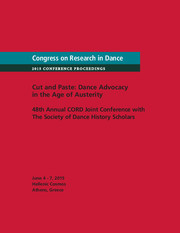No CrossRef data available.
Article contents
blind spot: Media, Memory, and Performing Resistance
Published online by Cambridge University Press: 17 September 2015
Abstract
This performative lecture explores artistic, social, cultural, and philosophical issues embedded in interdisciplinary dance theater artist Michael Sakamoto's latest solo work, blind spot. Combining film, video, and photography, dance, and theatrical performance, blind spot attempts to tell a story of looking without seeing, yet with sudden, ephemeral flashes of insight. Using his own history and perception-projection as a racialized, “Asian-American” body practicing butoh, an “Asian” form, Michael speaks of self-contradiction, code switching, and embracing both socialized and subjective identity. Inspired by the Buddhist conception of impermanence and ontological questions of embodied truth in media-based art forms, blind spot is rooted in the belief that every moment is an instance of not knowing, simultaneously revealing our fear and desire, making life a circuitous, nonlinear journey of mapping such “blind spots.”
From Michael's artist statement on blind spot: The fear of not seeing is the same as that of not knowing. From implosive desire, we give primacy to sight at the cost of vision. Within and without language-delineated, behavioral paradigms, we alternate between embracing our passion/obsession and holding ourselves at arm's length in the third person. Our mediated image—dead to the world but with a life of its own—becomes both bulwark against and support for the tenuous, febrile cord connecting us to heredity and lineage in the ways we both speak and act.
- Type
- Research Article
- Information
- Copyright
- Copyright © Michael Sakamoto 2015


